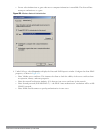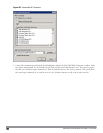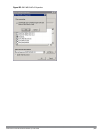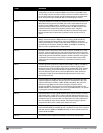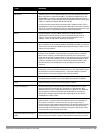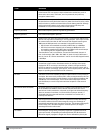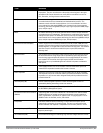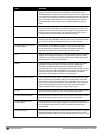
Term Definition
802.11 bSec
The bSec protocol is a pre-standard protocol that has been proposed to the IEEE
802.11 committee as an alternative to 802.11i. The difference between bSec and
standard 802.11i is that bSec implements Suite B algorithms whenever possible.
Notably, AES-CCM is replaced by AES-CGM, and the Key Derivation Function (KDF)
of 802.11i is upgraded to support SHA-256 and SHA-384.
In order to provide interoperability with standard Wi-Fi software drivers, bSec is
implemented as a shim layer between standard 802.11 Wi-Fi and a Layer 3 protocol
such as IP. A controller configured to advertise a bSec SSID will advertise an open
network, however only bSec frames will be permitted on the network.
802.1X Standard designed to enhance 802.11 WLAN security. 802.1X provides an
authentication framework, allowing a user to be authenticated by a central
authority. The actual algorithm that is used to determine whether a user is
authentic is left open and multiple algorithms are possible.
access point (AP) An access point connects users to other users within the network and also can
serve as the point of interconnection between the WLAN and a fixed wire network.
The number of access points a WLAN needs is determined by the number of users
and the size of the network.
access point mapping The act of locating and possibly exploiting connections to WLANs while driving
around a city or elsewhere. To do war driving, you need a vehicle, a computer
(which can be a laptop), a wireless Ethernet card set to work in promiscuous
mode, and some kind of an antenna which can be mounted on top of or positioned
inside the car. Because a WLAN may have a range that extends beyond an office
building, an outside user may be able to intrude into the network, obtain a free
Internet connection, and possibly gain access to company records and other
resources.
ad-hoc network A LAN or other small network, especially one with wireless or temporary plug-in
connections, in which some of the network devices are part of the network only for
the duration of a communications session or, in the case of mobile or portable
devices, while in some close proximity to the rest of the network.
A-MSDU A structure containing multiple MSDUs , transported within a single
(unfragmented) data medium access control (MAC) protocol data unit (MPDU).
band A specified range of frequencies of electromagnetic radiation.
digital wireless pulse Wireless technology for transmitting large amounts of digital data over a wide
spectrum of frequency bands with very low power for a short distance. Ultra
wideband radio can carry a huge amount of data over a distance up to 230 feet at
very low power (less than 0.5 milliwatts), and has the ability to carry signals
through doors and other obstacles that tend to reflect signals at more limited
bandwidths and a higher power.
evil twin A home-made wireless access point that masquerades as a legitimate one to
gather personal or corporate information without the end-user's knowledge. It's
fairly easy for an attacker to create an evil twin by simply using a laptop, a
wireless card and some readily-available software. The attacker positions himself
in the vicinity of a legitimate Wi-Fi access point and lets his computer discover
what name and radio frequency the legitimate access point uses. He then sends
out his own radio signal, using the same name.
extensible authentication protocol
(EAP)
Authentication protocol for wireless networks that expands on methods used by the
point-to-point protocol (PPP), a protocol often used when connecting a computer
DellPowerConnectW-SeriesArubaOS6.2 | User Guide Acronymsand Terms | 865



